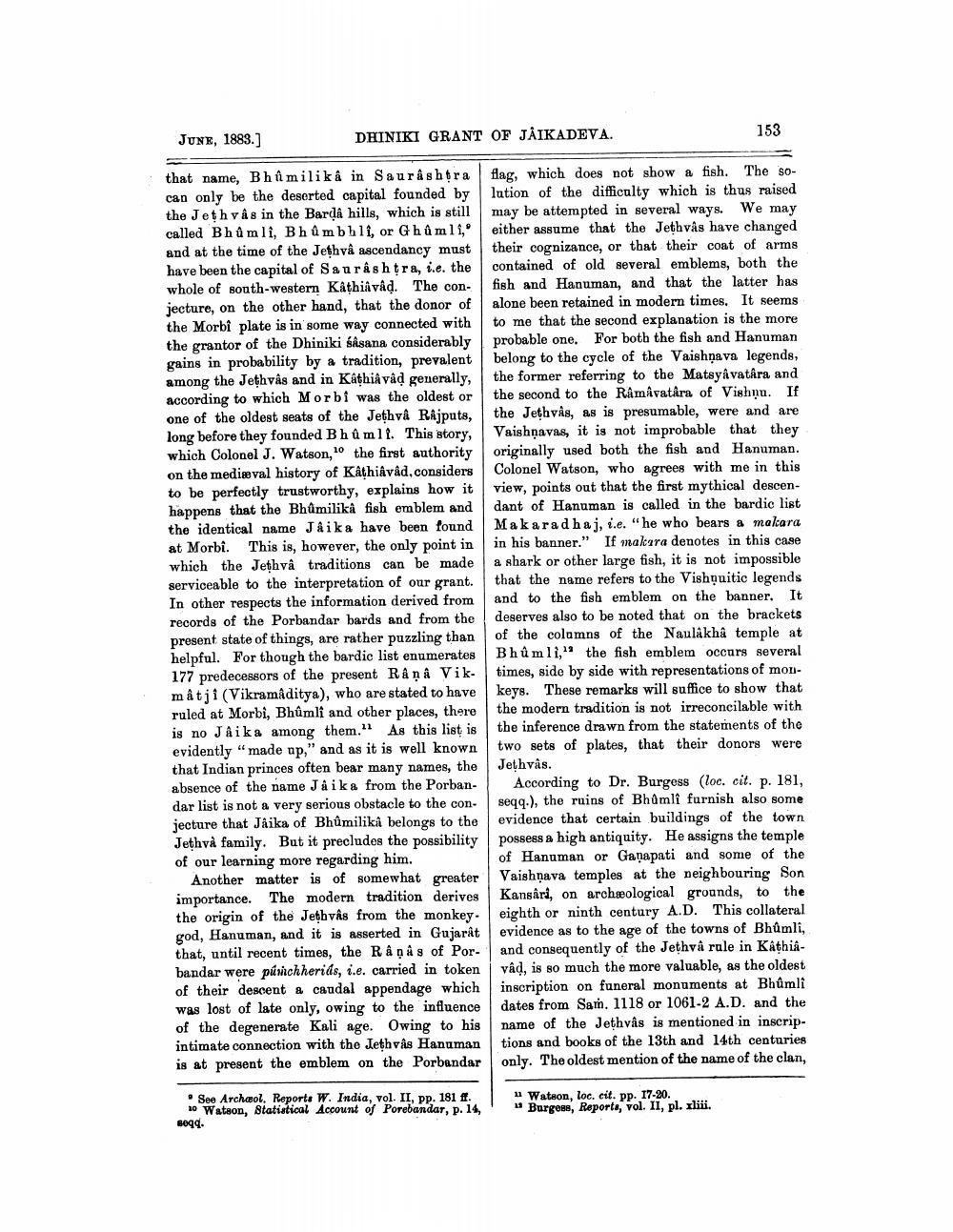________________
DHINIKI GRANT OF JAIKADEVA.
JUNE, 1883.]
that name, Bhumilikâ in Saurashtra can only be the deserted capital founded by the Jeth vâs in the Bardâ hills, which is still called Bhûmli, Bhûmbhli, or Ghûmli," and at the time of the Jethvâ ascendancy must have been the capital of Saurashtra, i.e. the whole of south-western Kâthiâvâḍ. The conjecture, on the other hand, that the donor of the Morbi plate is in some way connected with the grantor of the Dhiniki śâsana considerably gains in probability by a tradition, prevalent among the Jethvâs and in Kathiâ vâd generally, according to which Morbi was the oldest or one of the oldest seats of the Jethvå Rajputs, long before they founded Bhû mlt. This story, which Colonel J. Watson, 10 the first authority on the medieval history of Kâthiâvâd, considers to be perfectly trustworthy, explains how it happens that the Bhumilika fish emblem and the identical name Jâika have been found at Morbi. This is, however, the only point in which the Jethvâ traditions can be made serviceable to the interpretation of our grant. In other respects the information derived from records of the Porbandar bards and from the present state of things, are rather puzzling than helpful. For though the bardic list enumerates 177 predecessors of the present Rânâ Vikmâtji (Vikramaditya), who are stated to have ruled at Morbi, Bhûmli and other places, there is no Jika among them." As this list is evidently "made up," and as it is well known that Indian princes often bear many names, the absence of the name Jaika from the Porbandar list is not a very serious obstacle to the conjecture that Jaika of Bhûmilika belongs to the Jethvà family. But it precludes the possibility of our learning more regarding him.
Another matter is of somewhat greater importance. The modern tradition derives the origin of the Jethvâs from the monkey. god, Hanuman, and it is asserted in Gujarât that, until recent times, the Rânâs of Porbandar were pushchherids, i.e. carried in token of their descent a caudal appendage which was lost of late only, owing to the influence of the degenerate Kali age. Owing to his intimate connection with the Jethvâs Hanuman is at present the emblem on the Porbandar
See Archeol. Reports W. India, vol. II, pp. 181 ff. 10 Watson, Statistical Account of Porebandar, p. 14, seqq.
153
flag, which does not show a fish. The solution of the difficulty which is thus raised may be attempted in several ways. We may either assume that the Jethvâs have changed their cognizance, or that their coat of arms contained of old several emblems, both the fish and Hanuman, and that the latter has alone been retained in modern times. It seems. to me that the second explanation is the more probable one. For both the fish and Hanuman belong to the cycle of the Vaishnava legends, the former referring to the Matsyâvatâra and the second to the Râmâvatâra of Vishnu. If the Jethvâs, as is presumable, were and are Vaishnavas, it is not improbable that they originally used both the fish and Hanuman. Colonel Watson, who agrees with me in this view, points out that the first mythical descendant of Hanuman is called in the bardic list Makaradhaj, i.e. "he who bears a makara in his banner." If makara denotes in this case a shark or other large fish, it is not impossible that the name refers to the Vishnuitic legends and to the fish emblem on the banner. It deserves also to be noted that on the brackets of the columns of the Naulakhâ temple at Bhûmli, the fish emblem occurs several times, side by side with representations of monkeys. These remarks will suffice to show that the modern tradition is not irreconcilable with the inference drawn from the statements of the two sets of plates, that their donors were Jethvas.
According to Dr. Burgess (loc. cit. p. 181, seqq.), the ruins of Bhumlî furnish also some evidence that certain buildings of the town. possess a high antiquity. He assigns the temple of Hanuman or Ganapati and some of the Vaishnava temples at the neighbouring Son Kansâri, on archeological grounds, to the eighth or ninth century A.D. This collateral evidence as to the age of the towns of Bhûmli, and consequently of the Jethvâ rule in Kathiâvâd, is so much the more valuable, as the oldest inscription on funeral monuments at Bhûmli dates from Sam. 1118 or 1061-2 A.D. and the name of the Jethvâs is mentioned in inscriptions and books of the 13th and 14th centuries only. The oldest mention of the name of the clan,
Watson, loc. cit. pp. 17-20.
1 Burgess, Reports, vol. II, pl. xliii.




